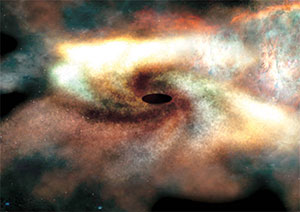When David poses as Goliath

A black hole Image: FAU
Stellar black holes form when massive stars end their life in a dramatic collapse. Observations have shown that stellar black holes typically have masses of about ten times that of the Sun, in accordance with the theory of stellar evolution.
Recently, a Chinese team of astronomers claimed to have discovered a black hole as massive as 70 solar masses, which, if confirmed, would severely challenge the current view of stellar evolution.
The publication immediately triggered theoretical investigations as well as additional observations by other astrophysicists. Among those to take a closer look at the object was a team of astronomers from the Universities of Erlangen-Nürnberg and Potsdam.
They discovered that it may not necessarily be a black hole at all, but possibly a massive neutron star or even an ‘ordinary’ star. Their results have now been published as a highlight-paper in the renowned journal ‘Astronomy & Astrophysics’ *.
The putative black hole was detected indirectly from the motion of a bright companion star, orbiting an invisible compact object over a period of about 80 days. From new observations, a Belgian team showed that the original measurements were misinterpreted and that the mass of the black hole is, in fact, very uncertain.
The most important question, namely how the observed binary system was created, remains unanswered. A crucial aspect is the mass of the visible companion, the hot star LS V+22 25. The more massive this star is, the more massive the black hole has to be to induce the observed motion of the bright star. The latter was considered to be a normal star, eight times more massive than the Sun.
A team of astronomers from Friedrich-Alexander-Universität Erlangen-Nürnberg (FAU) and the University of Potsdam had a closer look at the archival spectrum of LS V+22 25, taken by the Keck telescope at Mauna Kea, Hawaii.
In particular, they were interested in studying the abundances of the chemical elements on the stellar surface. Interestingly, they detected deviations in the abundances of helium, carbon, nitrogen, and oxygen compared to the standard composition of a young massive star.
The observed pattern on the surface showed ashes resulting from the nuclear fusion of hydrogen, a process that only happens deep in the core of young stars and would not be expected to be detected at its surface.
‘At first glance, the spectrum did indeed look like one from a young massive star. However, several properties appeared rather suspicious. This motivated us to have a fresh look at the archival data,’ said Andreas Irrgang, the leading scientist of this study and a member of the Dr. Karl Remeis-Observatory in Bamberg, the Astronomical Institute of FAU.
The authors concluded that LS V+22 25 must have interacted with its compact companion in the past. During this episode of mass-transfer, the outer layers of the star were removed and now the stripped helium core is visible, enriched with the ashes from the burning of hydrogen.
However, stripped helium stars are much lighter than their normal counterparts. Combining their results with recent distance measurements from the Gaia space telescope, the authors determined a most likely stellar mass of only 1.1 (with an uncertainty of +/-0.5) times that of the Sun.
This yields a minimum mass of only 2-3 solar masses for the compact companion, suggesting that it may not necessarily be a black hole at all, but possibly a massive neutron star or even an ‘ordinary’ star.
The star LS V+22 25 has become famous for possibly having a massive black hole companion. However, a closer look at the star itself reveals that it is a very intriguing object in its own right, as whilst stripped helium stars of intermediate mass have been predicted in theory, only very few have been discovered so far. They are key objects to understanding binary star interactions.
* doi: https://doi.org/10.1051/0004-6361/201937343
Further information:
Dr. Andreas Irrgang
Phone: +49 951 9522216
andreas.irrgang@fau.de
Dr. Andreas Irrgang
Phone: +49 951 9522216
andreas.irrgang@fau.de
Media Contact
More Information:
https://www.fau.eu/2020/01/10/news/research/when-david-poses-as-goliath/All latest news from the category: Physics and Astronomy
This area deals with the fundamental laws and building blocks of nature and how they interact, the properties and the behavior of matter, and research into space and time and their structures.
innovations-report provides in-depth reports and articles on subjects such as astrophysics, laser technologies, nuclear, quantum, particle and solid-state physics, nanotechnologies, planetary research and findings (Mars, Venus) and developments related to the Hubble Telescope.
Newest articles

NASA: Mystery of life’s handedness deepens
The mystery of why life uses molecules with specific orientations has deepened with a NASA-funded discovery that RNA — a key molecule thought to have potentially held the instructions for…

What are the effects of historic lithium mining on water quality?
Study reveals low levels of common contaminants but high levels of other elements in waters associated with an abandoned lithium mine. Lithium ore and mining waste from a historic lithium…

Quantum-inspired design boosts efficiency of heat-to-electricity conversion
Rice engineers take unconventional route to improving thermophotovoltaic systems. Researchers at Rice University have found a new way to improve a key element of thermophotovoltaic (TPV) systems, which convert heat…



